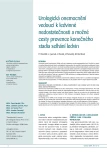THREE KINDS OF RESOURCES FOR KIDNEY TRANSPLANTATION
Authors:
P. Navrátil; M. Gerlichová; P. Měřička; J. Pacovsky; V. Černý
Authors‘ workplace:
Transplantační centrum při Urologické klinice FN a LF UK v Hradci Králové, Klinika anesteziologie, resuscitace a intenzivní medicíny FN a LF UK v Hradci Králové, Tkáňová ústředna FN v Hradci Králové
Published in:
Urol List 2009; 7(1): 14-17
Overview
The shortage of organs for transplantation leads to the necessity of finding and using all the possibilities for legal organ harvesting. Nowadays there are three resources for organ harvesting: living donors (LD), donors after brain death (DBD) and donors after cardiac death (DCD, NHBD). The quality of these organs and also the methods of harvesting are different. The legislation differs as well, compliance with these legal principles is absolutely necessary.
KEY WORDS:
donor, brain death, transplantation, non-heart beating donors, maastricht categorization, warm ischemic time
Sources
1. Sulková S et al. Hemodialýza. Praha: Maxdorf 2000.
2. Küss R, Bourget P. An Illustrated History of Organ Transplantation, The Great Adventure of the Century. Rueil-Malmaison: Laboratoires Sandoz 1992.
3. Bradley JA, Hamilton DNH. Organ Transplantation: an Historical Perspective. In: Transplantation Surgery. London: Springer 2001: 1–23.
4. Třeška V et al. Transplantologie pro mediky. 1. ed. Praha: Karolinum 2002.
5. Rudich SM, Kaplan B, Magee JC et al. Renal transplantations performed using non-heart beating organ donors: going back to the future? Transplantation 2002; 74(12): 1715–1720.
6. Nishikido M, Noguchi M, Koga S et al. Kidney transplantation from non-heart beating donors: analysis of organ procurement and outcome. Transplant Proc 2004; 36(7): 1888–1890.
7. Keizer KM, de Fijter JW, Haase-Kromwijk BJ et al. Non-heart beating donor kidney in the Netherlands: allocation and outcome of transplantation. Transplantation 2005; 79(9): 1195–1199.
8. Třeška V, Hasman D, Reischig T et al. Transplantace ledvin od nebijících dárců. Praha: Maxdorf 2008.
9. British Transplantation Society. Guidelines relating to solid organ transplants from non-heart beating donors. 2004.
10. Nadey H, Danovitch G. Transplantation surgery. London: Springer-Verlag 2001: 249–261.
11. A Position Paper by the Ethics Committee, American College of Critical Care Medicine, Society of Critical Care Medicine. Recommendations for non-heart beating organ donation. Critical Care Medicine 2001; vol. 29(9): 1826–1831.
12. Valero R, Sanchéz J, Caber C et al. Organ procurement from non-heart beating donors through in situ perfusion or total body cooling. Transplantation Proceedings 1995; 27: 2899–2900.
13. European Best Practice Guidelines. II.2 Cadaveric non-heart beating donors (NHBD). Nephrology Dialysis Transplantation 2000; 15(supl. 7): 39–51.
14. Třeška V, Racek J, Kuntscher V et al. Plasma and tissue levels of free oxygen radicals in recipients of kidney from non-heart beating donors: does recipient pretreatment with antioxidant drugs make sense? An experimetal study in pigs. Transplantation proceedings 2002; vol. 34: 3060–3064.
15. Bos MA. Ethical and Legal Issues in Non-Heart Beating Organ Donation. Transplantation 2005; 79: 1143–1147.
16. Zamparetti N, Bellomo R, Ronco C. Defining death in non-heart beating organ donors. Journal of Medical Ethics 2003; 29: 182–185.
17. Gerlichová M, Černý V, Navrátil P et al. Dárci s nebijícím srdcem. Anesteziologie a intenzivní medicína 2007; vol. 4(18): 236–240.
Labels
Paediatric urologist UrologyArticle was published in
Urological Journal

2009 Issue 1
Most read in this issue
- UROLOGICAL COMPLICATIONS AFTER KIDNEY TRANSPLANTATION
- SURGICAL TECHNIQUES IN KIDNEY TRANSPLANTATION
- UROLOGICAL DISEASES CONTRIBUTING TO RENAL INSUFFICIENCY AND POSSIBLE WAYS OF END STAGE RENAL DISEASE PREVENTION
- THREE KINDS OF RESOURCES FOR KIDNEY TRANSPLANTATION
